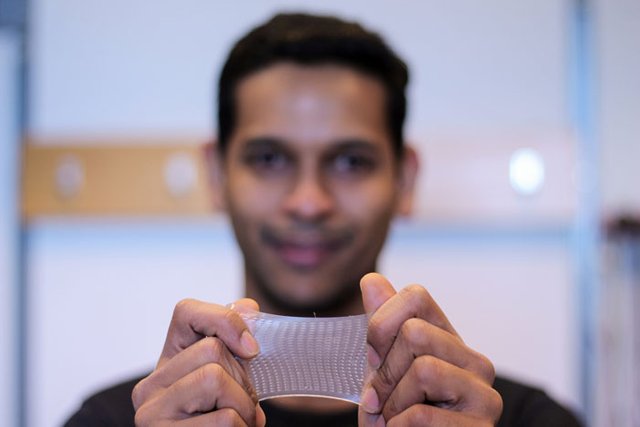This New Hyper-Flexible Touchscreen will make Your Next Phone Bend & Stretch!
Picture a tablet that you can fold into the size of a phone and can put away in your pocket, or an artificial skin that can sense your body's movements and vital signs.
A new and inexpensive sensor has been manufactured at the University of British Columbia, Canada that could help make advanced devices like these a reality.
Stretchable & Bendable Phones
The Canadian researchers have discovered Hyper-Flexible touch-sensitive material that can make upcoming phones stretch and bend when it is not being used. This time Scientists have come up with new soft touch sensor instead of going for unbreakable screens. These sensors use a highly conductive gel wedged between layers of silicone that is able to detect different types of touch, including tapping and swiping, even when it is folded, stretched or bent. This feature makes it suitable for stretchable devices of the future.
Engineer Mirza Saqib Sarwar from the University of British Columbia told CBC News-
"It's the first transparent touch sensor that is still able to detect a touch while being actively deformed,"
Malleable displays have been a focus of intense scientific interest for years, with scientists looking to make smartphones that can be bent, touchscreens that can be stretched, and even Televisions that can be rolled up like a newspaper.
"Sensors detect pressure similar to the iPhone's 3D Touch that can identify a hovering finger. In this technology, all sensors are transparent and can be bend and stretchable. Our contribution is to make a device that can do perform all functions in integrated one packet." - Sarwar
Soft sensors
Scientists are focusing on developing a new kind of virtual touch. It is one thing to make a malleable device that registers touch even when it's deformed, but it's even more of a challenge to make the same material detect fingers that aren't even in contact with the device.
For this, the team of researchers used Hydrogel electrodes that are encapsulated in the silicon layers, which provides electric field over the sensors. It is really a great challenge to make a malleable device that can detect the touch when it is deformed. Although, a greater challenge is in making the same material detect your fingers that aren't even in contact with the device yet.
The experiment is done on 5cm*5cm (2inch*2inch) prototype; the electrodes empower the sensors to detect a touch a few centimeters above the materials. While this prototype is small, the researchers say it would be easy and affordable to fabricate the larger sensors for bigger devices or to make malleable touch sensors for considerably more expansive settings.
"It's entirely possible to make a room-sized version of this sensor for just dollars per square meter, and then put sensors on the wall, on the floor, or over the surface of the body - almost anything that requires a transparent, stretchable touch screen. And because it's cheap to manufacture, it could be embedded cost-effectively in disposable wearables like health monitors" - Sarwar.
Flexible Future
The sensor could also be used as an artificial skin; Our bodies will feel comfortable by just wearing an adaptive health sensor. The sensor could also be compacted in robotic skins to make human-robot interactions safer.
The team wants to make much larger sensors, about the size of a room so that they can be used on floors. These touchscreen sensors will be used to alert the staff in elderly care units e.g. if somebody has fallen over and also able to tell how many people are standing on a particular floor area. Looking further ahead, the researchers believe that their research about this could be beneficial in other ways also. They think that it would help to make robots safer for humans if they get covered in the soft sensory material.
<iframe width="854" height="480" src="
A team member, John Madden said -
Currently, machines are kept separate from humans in the workplace because of the possibility that they could injure humans. If a robot could detect our presence and be soft enough that they don't damage us during an interaction, we can safely exchange tools with them, they can pick up objects without damaging them, and they can safely probe their environment.
No one likes shattering their brand new smartphone display, and having to operate the device by running fingers over shards of jagged glass, or paying hefty prices just to get the display replaced. This new revolutionary Hyper-Flexible touch sensor could make all of that history, and potentially open the path to a lot more futuristic sci-fi world.
Thank you for reading. If you liked the content, hit that upvote button, resteem, and follow me for more awesome stuff like this!
See more of my stuff here. I post about Technology, Gaming, and Mixed Martial Arts (MMA).
*All images are assumed to be from public domains.*


My kids will find a way to smash it in 48 hours.
haha. kids have been a cause for a lot of broken screens.
If it's not too gimmicky, then yeah I could see this as revolutionary. But it would be nice if Nintendo Switch or other game consoles can implement this feature. Laptops on the other hand, are a different issue entirely.
Great post!! Re-steemed guaranteed!!!
Thanks for the re-steem. I think hand held consoles will benefit from this tech.
That would be really cool.